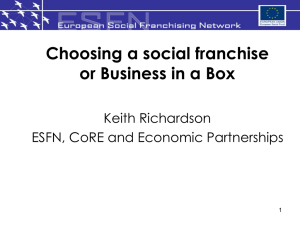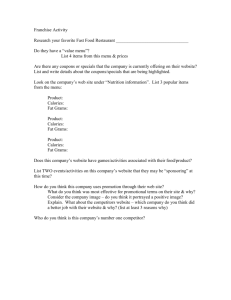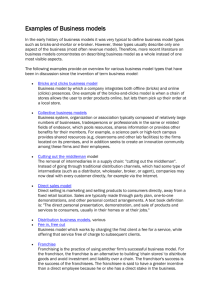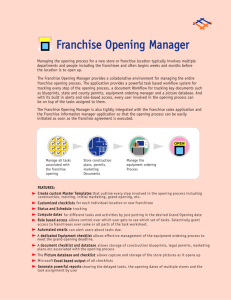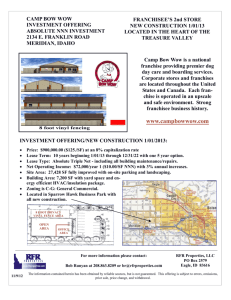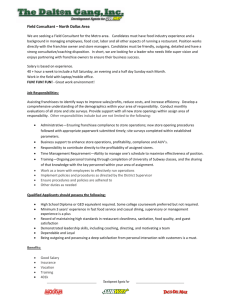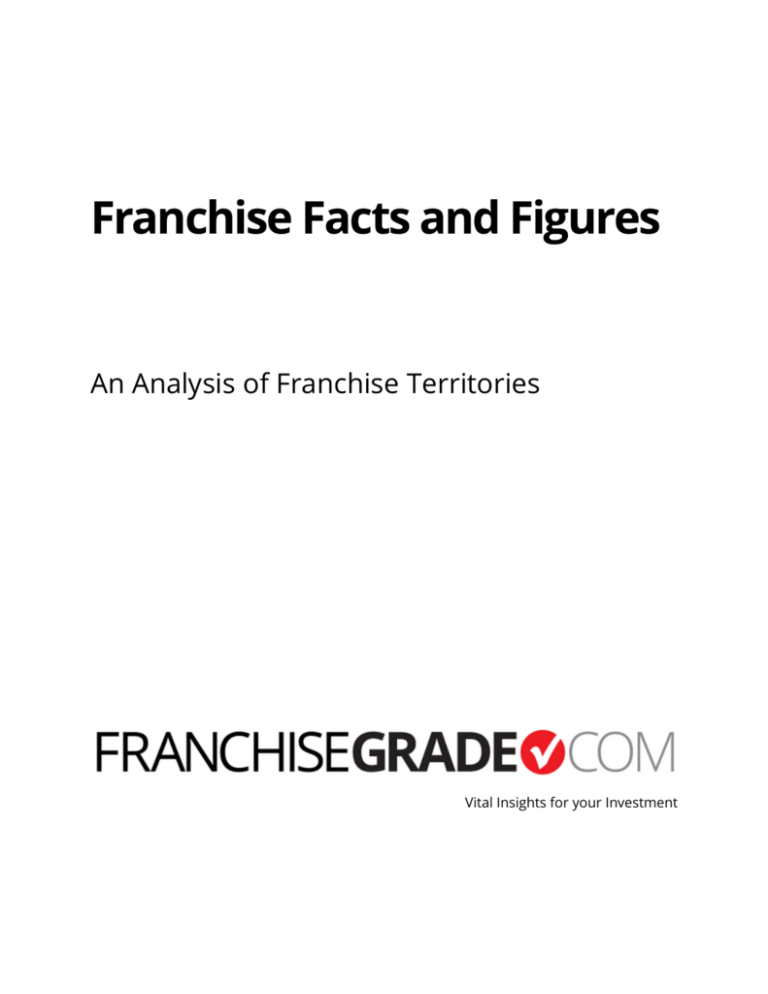
Franchise Facts and Figures
An Analysis of Franchise Territories
Vital Insights for your Investment
Franchise Facts and Figures: Franchise Territories
June 2015
Territory rights can be a critical component of a prospective franchisee’s decision to
purchase a franchise.
Our analysis of franchise territories is based upon Franchise Disclosure Documents.
According to the FTC when a franchisor FDD states in Item 12 that it grants an
Exclusive Territory the FTC requires that: “A franchisor may state in Item 12 that it
grants an “exclusive territory” only if the franchisor contractually “promises not to
establish either a company-owned or franchised outlet selling the same or similar goods
or services under the same or similar trademarks or service marks” within the
geographic area or territory granted to a franchisee. A reservation of rights to open
outlets selling the same goods or services under the same trademarks or service marks
within a franchisee’s territory negates any such commitment and triggers the Item 12
requirement to include a disclaimer stating that franchisees will not receive an exclusive
territory.”
Two types of territories are typically presented in the FDD;
Exclusive Territory in which the franchisor will not compete or allow others to
compete. This must be disclosed in the FDD as an “Exclusive Territory” and must list
the rights of non-competition. This territory does not always have the boundaries
defined as they may be negotiated in the Franchise Agreement. An Exclusive
territory effectively supersedes a “Protected Territory”, but some franchisors
include both terms in their Item 12 disclosure.
Protected Territory is defined when certain protections are offered. However,
some rights are reserved by the Franchisor, usually regarding other channels of
distribution or proximity to the territory. This protection must be defined in the
FDD. It is often disclosed as a “Protected Territory” with the Franchisor's reserved
rights defined. It also includes a statement such as “this territory is not exclusive due
to certain reserved rights and the franchisee may have competition from other
franchisees or company outlets”.
insights@franchisegrade.com
1 (800) 975 6101
Franchise Facts and Figures: Franchise Territories
June 2015
Certain franchise systems also disclose boundaries or other territorial rights of the
franchise. These may or may not be exclusive or protected.
Defined Territory is independent of exclusive or protected. Boundaries are
defined and the parameters are disclosed in the FDD. If the territory is defined yet
not exclusive or protected, it typically indicates a trade or marketing area in which
the franchisee is restricted to operate.
No Territorial Rights can be explicitly stated in the FDD and clearly identify that
there are no rights with regards to exclusivity, protection, non-competition, or
boundaries.
Occasionally a territory is non-exclusive, not protected and not defined although it
contains rights. Typically these are disclosed as a territory to be negotiated that will
be defined by certain parameters such as Political Boundaries, Zip Codes, Distance,
etc.
Defined territories are based upon particular criteria that outline specific
boundaries or a marketing radius. These can be included in an exclusive or
protected territory, or can be specific to the marketing area in which the franchisee
is allowed to operate.
Examples of various Defined territories include:
•
General populations such as 100,000 people to specific sub-groups of a
population such as school age children or adults 65+ years of age.
•
Geographic radius based on miles, or other geographic indicators such as
number of blocks, delivery time, urban or rural, number of shopping malls,
school districts, etc.
•
Political boundaries such as ZIP codes, counties, town lines or state borders.
•
System or sector specific parameters such as number of businesses, owner
occupied households, number of vehicles, topographical features, private
schools, etc.
insights@franchisegrade.com
1 (800) 975 6101
Franchise Facts and Figures: Franchise Territories
June 2015
Exceptions within protected territories can include:
•
Minimum sales quotas
•
Minimum performance metrics
•
Minimum royalties paid
•
Internet Sales
•
Maintaining minimum sales/revenue
•
Special events (trade shows, stadiums, and concerts)
•
Locations (military bases, public transportation facilities, and airports)
•
National accounts
A number of franchisors list the territory with the word "exclusive", but
reserve the right to establish alternative methods of distribution for product
49% of all franchise systems provide some form of territory
protection for franchisees.
Our analysis revealed the following results by franchise sector:
•
The Real Estate, Retail Products and Services and Commercial and
Residential Services franchise sectors provide the highest percent of
Exclusive Territories
•
The Lodging, QSR and Table/Full Service Restaurants sectors provide the
lowest percent of Exclusive Territories
•
The Retail Products and Services, Personal Services and Automotive Services
franchise sectors provide the highest percent of combined Exclusive and
Protected Territories
insights@franchisegrade.com
1 (800) 975 6101
Franchise Facts and Figures: Franchise Territories
June 2015
Sector Breakdown of Territory Rights
Exclusive Protected Combined
Defined
Automotive
24.0%
28.0%
52.0%
44.0%
Business Services
18.0%
19.7%
37.7%
65.6%
Commercial & Residential Services
33.0%
17.4%
50.5%
68.8%
3.2%
46.8%
50.0%
8.1%
30.8%
32.0%
57.5%
35.2%
71.2%
Quick Service Restaurants
26.7%
3.2%
40.8%
Real Estate
33.3%
20.0%
Retail Food
Retail Products & Services
23.5%
31.1%
11.8%
53.3%
35.3%
40.0%
47.1%
33.3%
64.4%
60.0%
5.3%
44.7%
50.0%
44.7%
Lodging
Personal Services
Table/Full Service Restaurants
Based on a sample of 654 2015 FDDs representing 236,870 franchisees
What does all of this mean for prospective franchisees?
Territorial rights can significantly influence your revenue capacity. If there are no
territorial rights, business and goodwill created by your efforts can be lost due to
new (competing) outlets within the same franchise.
What does this mean for franchisors?
Franchisors need to have a clear understanding of the market demographics and
what type of penetration is needed to saturate the market. Identifying a balance
between market penetration and franchisee exclusive or protected territories
allows both parties to work together.
insights@franchisegrade.com
1 (800) 975 6101
Franchise Facts and Figures: Franchise Territories
June 2015
About FranchiseGrade.com
FranchiseGrade.com is the leader in competitive market research and objective
analysis for the franchise industry. We compare and grade franchise systems for
their investment value. Our motivation is simple: we want to raise the bar in
franchise industry market research and build a stronger franchise community in
the process. By surveying as many as 18,000 franchisees and reviewing more than
2,400 Franchise Disclosure Documents every year we are able to maintain an
extensive database of current franchising information for our industry leading
research and analysis.
Our reports, reviews and assessment services are available to Franchisees,
Franchisors and Investors alike:
System Report Cards
Franchise Disclosure Documents
Sector Reports
FDD Competitive Assessments
Franchise Buyer's Package
Enterprise Intelligence
For information, contact insights@franchisegrade.com or call 1 (800) 975 6101
insights@franchisegrade.com
1 (800) 975 6101





